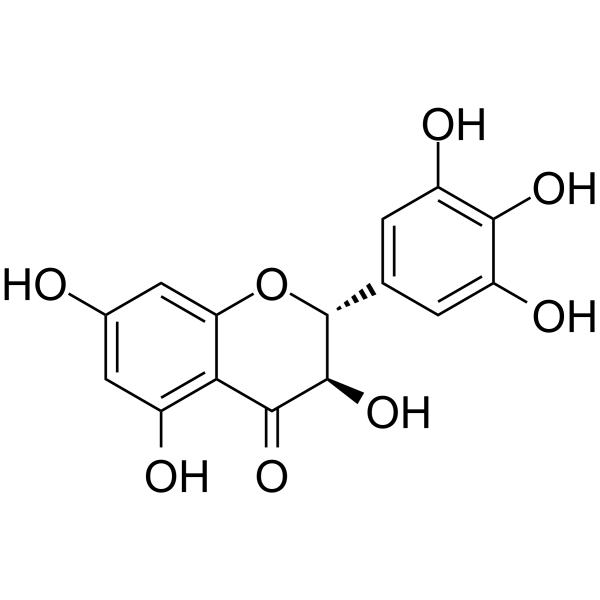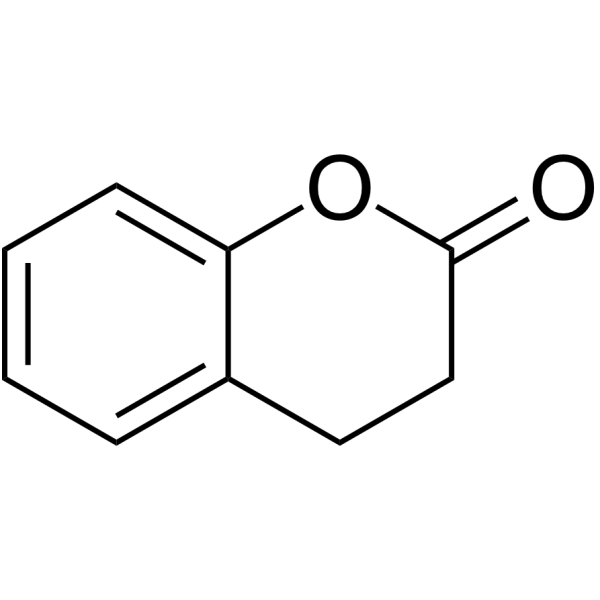天然产物 黄酮类 Flavonoids
Dihydromyricetin (Synonyms: 二氢杨梅素; Ampelopsin; Ampeloptin) 纯度: 99.79%
Dihydromyricetin 是一种有效的二氢嘧啶酶 (dihydropyrimidinase) 抑制剂,IC50 为 48 μM。Dihydromyricetin 可通过抑制 mTOR 信号从而激活自噬。Dihydromyricetin 抑制 mTOR 复合体 (mTORC1/2) 形成。Dihydromyricetin 还是一种流感依赖 RNA 的 RNA 聚合酶抑制剂,IC50 为 22 μM。

Dihydromyricetin Chemical Structure
CAS No. : 27200-12-0
| 规格 | 价格 | 是否有货 | 数量 |
|---|---|---|---|
| Free Sample (0.1-0.5 mg) | Apply now | ||
| 10 mM * 1 mL in DMSO | ¥500 | In-stock | |
| 5 mg | ¥350 | In-stock | |
| 10 mg | ¥500 | In-stock | |
| 50 mg | ¥850 | In-stock | |
| 100 mg | ¥1500 | In-stock | |
| 200 mg | 询价 | ||
| 500 mg | 询价 |
* Please select Quantity before adding items.
Dihydromyricetin 相关产品
•相关化合物库:
- Natural Product Library Plus
- Drug Repurposing Compound Library Plus
- Clinical Compound Library Plus
- Bioactive Compound Library Plus
- Anti-Infection Compound Library
- Cell Cycle/DNA Damage Compound Library
- Kinase Inhibitor Library
- PI3K/Akt/mTOR Compound Library
- Stem Cell Signaling Compound Library
- Natural Product Library
- Anti-Cancer Compound Library
- Clinical Compound Library
- Antiviral Compound Library
- Autophagy Compound Library
- Anti-Aging Compound Library
- Drug Repurposing Compound Library
- Antioxidants Compound Library
- Differentiation Inducing Compound Library
- Reprogramming Compound Library
- Oxygen Sensing Compound Library
- Anti-COVID-19 Compound Library
- Medicine Food Homology Compound Library
- Phenols Library
- Glycolysis Compound Library
- Cytoskeleton Compound Library
- Glutamine Metabolism Compound Library
- Traditional Chinese Medicine Monomer Library
- Flavonoids Library
- Anti-Breast Cancer Compound Library
- Anti-Lung Cancer Compound Library
- Anti-Pancreatic Cancer Compound Library
- Anti-Blood Cancer Compound Library
- Anti-Cancer Metabolism Compound Library
- Angiogenesis Related Compound Library
- Lipid Metabolism Compound Library
- Glucose Metabolism Compound Library
- Food-Sourced Compound Library
- Anti-Liver Cancer Compound Library
- Anti-Colorectal Cancer Compound Library
| 生物活性 |
Dihydromyricetin is a potent inhibitor with an IC50 of 48 μM on dihydropyrimidinase. Dihydromyricetin can activate autophagy through inhibiting mTOR signaling. Dihydromyricetin suppresses the formation of mTOR complexes (mTORC1/2). Dihydromyricetin is also a potent influenza RNA-dependent RNA polymerase inhibitor with an IC50 of 22 μM. |
||||||||||||||||
|---|---|---|---|---|---|---|---|---|---|---|---|---|---|---|---|---|---|
| IC50 & Target |
|
||||||||||||||||
| 体外研究 (In Vitro) |
Dihydromyricetin, a flavonol, significantly inhibits the catalytic activities of dihydropyrimidinase toward both the natural substrate dihydrouracil and xenobiotic substrate 5-propyl-hydantoin. Dihydromyricetin exhibits a significant inhibitory effect on the activities of dihydropyrimidinase for both substrates, even more than Myricetin does. The IC50 values of Dihydromyricetin for dihydropyrimidinase determined from the titration curves using Dihydrouracil and 5-propyl-hydantoin are 48±2 and 40±2 μM, respectively[1]. Dihydromyricetin (DHM) supplementation significantly reverses the increased phosphorylation of mTOR at Ser2448 (p-mTOR) during D-gal administration, which suggests that Dihydromyricetin can activate autophagy through inhibiting mTOR signaling[2]. Shanghai Jinpan Biotech Co Ltd has not independently confirmed the accuracy of these methods. They are for reference only. |
||||||||||||||||
| 体内研究 (In Vivo) |
Changes in learning and memory capacity in rats administrated normal control group, D-gal group, D-gal+Dihydromyricetin (100 mg/kg) group, D-gal+Dihydromyricetin (200 mg/kg) group assessed by morris water maze (MWM) (n=10 per group). Dihydromyricetin (DHM) treatment significantly shortens the escape latency when compared with D-gal-induced model group[2]. Shanghai Jinpan Biotech Co Ltd has not independently confirmed the accuracy of these methods. They are for reference only. |
||||||||||||||||
| Clinical Trial |
|
||||||||||||||||
| 分子量 |
320.25 |
||||||||||||||||
| Formula |
C15H12O8 |
||||||||||||||||
| CAS 号 |
27200-12-0 |
||||||||||||||||
| 中文名称 |
二氢杨梅素;白蔹素 |
||||||||||||||||
| 运输条件 |
Room temperature in continental US; may vary elsewhere. |
||||||||||||||||
| 储存方式 |
|
||||||||||||||||
| 溶解性数据 |
In Vitro:
DMSO : ≥ 100 mg/mL (312.26 mM) * “≥” means soluble, but saturation unknown. 配制储备液
*
请根据产品在不同溶剂中的溶解度选择合适的溶剂配制储备液;一旦配成溶液,请分装保存,避免反复冻融造成的产品失效。 In Vivo:
请根据您的实验动物和给药方式选择适当的溶解方案。以下溶解方案都请先按照 In Vitro 方式配制澄清的储备液,再依次添加助溶剂: ——为保证实验结果的可靠性,澄清的储备液可以根据储存条件,适当保存;体内实验的工作液,建议您现用现配,当天使用; 以下溶剂前显示的百
|
||||||||||||||||
| 参考文献 |
|
| Kinase Assay [1] |
A rapid spectrophotometric assay is used to determine the enzymatic activity for hydantoinase, allantoinase, dihydroorotase, and imidase. Dihydrouracil, 5-propyl-hydantoin, and phthalimide are used as substrates. Unless explicitly stated otherwise, Dihydrouracil (2 mM) is used as the substrate in the standard assay of dihydropyrimidinase. Briefly, the decrease in absorbancy at 230, 248, and 298 nm is measured upon hydrolysis of Dihydrouracil, 5-propyl-hydantoin, and Phthalimide as the substrate at 25°C, respectively. To start the reaction, the purified dihydropyrimidinase (10-70 μg) is added to a 2 mL solution containing the substrate and 100 mM Tris-HCl (pH 8.0). Substrate hydrolysis is monitored with a UV/vis spectrophotometer. The extinction coefficient of each substrate is determined experimentally by direct measurement with a spectrophotometer. The extinction coefficients of Dihydrouracil, 5-propyl-hydantoin, and Phthalimide are 0.683 mM-1cm-1 at 230 nm, 0.0538 mM-1cm-1 at 248 nm, and 3.12 mM-1cm-1 at 298 nm, respectively. The initial rates of change are a function of enzyme concentration within the absorbance range of 0.01-0.18 min-1. A unit of activity is defined as the amount of enzyme catalyzing the hydrolysis of 1 μmol substrate/min, and the specific activity is expressed in terms of units of activity per milligram of enzyme. The kinetic parameters Km and Vmax are determined from a non-linear plot by fitting the hydrolyzing rate from individual experiments to the Michaelis-Menten equation[1]. Shanghai Jinpan Biotech Co Ltd has not independently confirmed the accuracy of these methods. They are for reference only. |
|---|---|
| Cell Assay [2] |
Hippocampus and cortex tissue samples are homogenized in lysis buffer containing 20 mM Tris (pH 7.5), 135 mM NaCl, 2 mM EDTA, 2 mM DTT, 25 mM β-glycerophosphate, 2 mM sodium pyrophosphate, 10% glycerol, 1% Triton X-100, 1 mM sodium orthovanadate, 10 mM NaF, 10 μg/mL aprotinin, 10 μg/mL leupeptin, and 1 mM PMSF for 30 min on ice and centrifuged at 12000×g at 4°C for 30 min. The supernatant is collected and protein quantification is carried out using a BCA kit. The protein samples are boiled in the presence of sample buffer at 95°C for 5 min. The target protein is separated by sodium dodecyl sulfate polyacrylamide gel electrophoresis (SDS-PAGE), transferred to nitrocellulose membrane, and then probed by corresponding primary and secondary antibodies. Finally, the target protein is visualized by enhanced chemiluminescence (ECL) reagent exposure to X-ray film[2]. Shanghai Jinpan Biotech Co Ltd has not independently confirmed the accuracy of these methods. They are for reference only. |
| Animal Administration [2] |
Rats[2] Shanghai Jinpan Biotech Co Ltd has not independently confirmed the accuracy of these methods. They are for reference only. |
| 参考文献 |
|


